United Kingdom
Recipes

1 GEOGRAPHIC SETTING AND ENVIRONMENT
The United Kingdom (UK) is located just west of the mainland of Europe. It is made up of several islands, the largest of which is Great Britain. Great Britain is made up of Scotland in the north, England in the southeast and Wales in the southwest. Northern Ireland is the northwestern part of Ireland, a separate island nation just west of Great Britain, but it is also part of the UK. There has been violence in Northern Ireland for centuries because of religious and political conflict there. Because ocean waters surround the UK, it has a mild, rainy climate. The country's farmers produce about 60 percent of the food the UK needs. From 1980–90 the farming became more mechanized, with farmers using machinery to plant and harvest crops. The productivity of UK farms increased during that period by about 10 percent. More farmers raise livestock than crops, and some of the world's best beef and lamb is raised in the UK.
2 HISTORY AND FOOD
The United Kingdom (UK) has also been called the British Isles or Great Britain at different times in history. The UK consists of England, Wales, Scotland, and Northern Ireland. Each region has its own special cuisine. At various times the English have ruled over the entire region, including all of Ireland. The English style of cooking does not use many seasonings and is sometimes criticized for its bland taste. During the 1700s and 1800s, English explorers and colonists were trading and developing settlements in the Caribbean region, Asia, Africa, and North America. Their colonial interests around the world became known as the British Empire. The English were influenced by
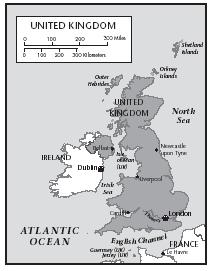
Salmon Kedgeree (British-Indian Salmon)
Ingredients
- 2 eggs
- 1 small onion, chopped
- 1¾ cups water
- ½ teaspoon salt
- 8 oz.
- can of salmon
- ¾ cup white rice
- 1 Tablespoon unsalted butter
- 2 Tablespoons chopped parsley leaves
- 1 Tablespoon lemon juice
- Lemon wedges as garnish, if desired
Procedure
- Prepare hardboiled eggs: Place eggs in a saucepan and cover them with cold water.
- Put the saucepan on a burner over medium-high heat and wait until the water just begins to simmer. (Tiny bubbles will form and move slowly to the surface of the water.) Lower the heat, and simmer the eggs for 15 minutes.
- Remove from heat and run cold water into the pan to stop the cooking. Allow the eggs to cool, and then remove the shells carefully. Cut the eggs lengthwise into quarters.
- Cook the rice: Prepare rice according to instructions on the package to yield about 2 cups of cooked rice.
- Next chop the onion.
- Heat butter in a large skillet until melted and add chopped onion. Cook onion, stirring constantly with a wooden spoon, until softened. Stir rice into the onion.
- Drain canned salmon and add to rice mixture, breaking up the salmon with the wooden spoon. Add parsley, and lemon juice. Cook together until heated through.
- Serve, garnished with slices of egg and lemon wedges.
Serves 6 to 8.
3 FOODS OF THE BRITISH
In Scotland the national dish is haggis . Haggis is comprised of sheep innards boiled in a sheep stomach. In Wales leeks, a relative of the onion, are used in many dishes. Welsh rarebit, comprised of a cheesy sauce over
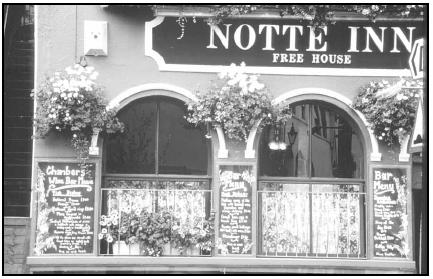
Lemon Curd
Prepared lemon curd may be purchased at many supermarkets. It is usually found near the jams and jellies.
Ingredients
- 2 sticks unsalted butter
- ½ cup fresh lemon juice, strained through a sieve
- ½ sugar
- 3 egg yolks
Procedure
- In a double boiler (one pot set inside a larger pot that contains about 2 inches of boiling water), melt the butter with the lemon juice and sugar, stirring until all the sugar dissolves.
- Add the egg yolks, one at a time, stirring constantly.
- Keep stirring until the mixture is as thick as yogurt (about 15 minutes).
- Pour the mixture through a sieve into a bowl.
- Cover with plastic wrap, making sure the plastic wrap touches the surface of the lemon curd to prevent a skin from forming. Refrigerate until cool.
- Serve on toast or fill purchased miniature tart shells with it.
Serves 12 to 15. Serve with tea.
Clotted cream and lemon curd?
Clotted cream—the name sounds like something that's been in the refrigerator past the expiration date, but clotted cream is truly a rich treat. It is thicker than whipped cream and is sold in containers, like sour cream or margarine, in the dairy section. Lemon curd is almost like a thick pudding. English people enjoy it for breakfast, or as a filling for little tarts.
Haggis
Ingredients
- 1 sheep's stomach
- 1 sheep heart
- 1 sheep liver
- ½ pound suet, fresh (kidney fat is preferred)
- ¾ cup oatmeal
- 1 teaspoon salt
- ½ teaspoon pepper
- ¼ teaspoon cayenne
- ½ teaspoon nutmeg
- ¾ cup stock
Procedure
- Wash stomach; rub with salt and rinse.
- Remove membranes and excess fat.
- Soak in cold salted water.
- Turn stomach inside out.
- Boil the heart and liver in water, and simmer for 30 minutes.
- Chop the heart and grate the liver.
- Toast the oatmeal until golden brown.
- Combine all ingredients and pack into the stomach, leaving enough room for the oatmeal to expand.
- Press excess air out of the stomach and sew it up.
- Simmer for three hours in a pot of water, pricking small holes in the stomach so that it doesn't explode.
Serve on a hot platter.
Welsh Rarebit
Ingredients
- ½ pound cheddar cheese, grated
- 1 Tablespoon butter
- ¼ cup milk (or beer)
- 1 teaspoon dried mustard powder
- Dash of Worcestershire sauce
- 4 slices thick bread, toasted
- Salt and pepper to taste
- Tomatoes, sliced
Procedure
- Preheat oven to 325°F.
- Put grated cheese, butter, milk, mustard powder, Worcestershire sauce, and salt and pepper in a saucepan.
- Heat over low heat, stirring constantly, until cheese is melted and the mixture is smooth and creamy.
- Toast bread, cut each piece into two triangles, and arrange in a casserole.
- Ladle cheese sauce over toast, and bake in the oven until crusty (about 15 minutes).
- Carefully remove two triangles of toast to a plate for each person, top with a slice of tomato, and serve.
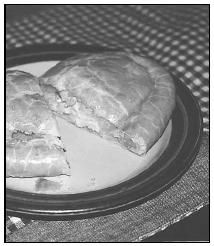
Cornish Pasties
Pastry ingredients
- 1 cup flour
- Pinch of salt
- ¾ cup butter
- Cold water
- 1 egg, broken into a small bowl and beaten
Filling ingredients
- ½ pound ground beef
- 1 medium onion, chopped
- 1 potato, chopped
- ½ teaspoon salt
- ½ teaspoon pepper
Procedure
- Preheat oven to 375°F and grease a cookie sheet.
- Make pastry (or purchase commercial piecrust mix or refrigerated piecrust): Combine flour and butter in a bowl, using two knives or a large fork to cut the butter into small pieces.
- Continue mixing until all the butter has been broken up and is thoroughly mixed with flour.
- Add cold water, one tablespoon at a time, until a soft dough is formed (2 to 4 tablespoons of water).
- Make filling: In a bowl, mix the ground meat, onion, potato, salt, and pepper.
- Stir with a wooden spoon to combine.
- Assemble pasties: Dust the counter or a large wooden cutting board with flour and roll out the pastry, using a rolling pin.
- Using a saucer as a template, cut dough into 5-inch rounds.
- Place about ¼ cup of the meat mixture in the center of each round.
- Pinch up the edges of the dough, almost covering the filling.
- Using a pastry brush, brush the pastry with the beaten egg.
- Place the pastie carefully on a greased baking sheet.
- Repeat to make 3 more pasties.
- Bake at 375°F for 50 to 55 minutes.
- Pastry should be golden brown, and filling should look bubbly and hot.
Toad-in-the-Hole
No one really knows the history behind the name of this traditional light supper dish.
Ingredients
- 2 cups all-purpose flour
- ¼ teaspoon salt
- 2 cups milk
- 6 eggs
- 2 pounds pork sausage links
- Applesauce as accompaniment
Procedure
- Preheat oven to 350°F.
- Prick sausages all over with a fork.
- Place in lightly greased 13x9-inch baking dish.
- Bake for 15 minutes at 350°F.
- While sausages are baking, measure flour and salt into a medium bowl.
- In another bowl, combine milk with eggs, and beat lightly with a wire whisk or fork.
- Gradually stir milk and eggs into flour mixture, stirring to make a smooth batter.
- Let stand for 30 minutes.
- When the sausages have baked for about 15 minutes, turn them and return pan to oven for 15 minutes more.
- Remove sausages to paper towels, and drain fat from pan.
- Return sausages to pan.
- Increase oven temperature to 425°F.
- Stir batter and pour over baked sausages.
- Bake the combination for 25 to 30 minutes, or until puffed and golden.
- Serve immediately.
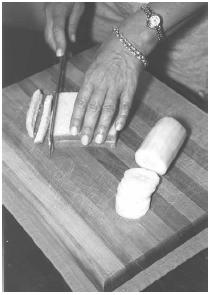
Cucumber Sandwiches
Ingredients
- 1 seedless cucumber
- 8 slices very thin-sliced white bread
- Salt, to taste
- Unsalted butter, at room temperature
Procedure
- Peel cucumber and slice crosswise very thin.
- Spread unsalted butter on one side of each slice of bread.
- Arrange cucumber slices in a single layer on 4 slices of bread.
- Salt lightly.
- Top with second slice of bread.
- Carefully trim crusts from sandwiches and discard.
- Cut each sandwich into triangles and arrange on a china plate.
Serve with tea. Serves 4.
Scones
Ingredients
- 1 cup self-raising flour
- 1 teaspoon baking powder
- Pinch of salt
- ¼ cup butter
- 1½ Tablespoons sugar
- 1 egg (beaten with enough milk to make ½ cup)
- Handful of currants or raisins (optional)
Procedure
- Sift flour, baking powder, and salt together in a mixing bowl.
- Add the butter, and rub it into the flour mixture, using very clean fingertips. Add the sugar.
- Add enough of the egg mixture to form a soft dough (not all the liquid will be needed).
- Add the currants or raisins (optional).
- Preheat over to 425°F.
- Roll out the dough on a floured surface to ¾-inch thickness.
- Use a 1½-inch round glass or pastry cutter to cut out the dough.
- Place the scones on a greased baking sheet and brush the tops with some of the egg mixture.
- Bake for 10 to 15 minutes.
Serve with fresh butter and jam at teatime.
4 FOOD FOR RELIGIOUS AND HOLIDAY CELEBRATIONS
On January 25 the Scots celebrate "Burns Night" for the birth of their favorite poet, Robert Burns (1759–96). The typical "Burns Night" meal includes a haggis, cock-a-leekie (chicken with leeks) , tatties n' neeps (potatoes and turnips or rutabagas), roast beef, tipsy laird (a cream cake made with whiskey), and Dunlop cheese (resembles a soft cheddar). The Scots drink Scotch whiskey at celebrations.
Tatties n' Neeps
Ingredients
- 4 large potatoes, peeled and cut into quarters
- 1 Tablespoon chopped chives
- 2 turnips or rutabagas, peeled and cut into large chunks
- 1 Tablespoon butter
- Salt and pepper, to taste
Procedure
- Peel and quarter potatoes, place in a large saucepan, and cover with water.
- Heat the water until it boils, and cook potatoes until they are soft (about 15 minutes).
- Drain, return potatoes to the saucepan, and mash.
- Place the peeled and cut-up turnips or rutabagas into a saucepan, cover with water, and heat the water to boiling.
- Cook until the vegetable is soft, about 15 minutes.
- Drain, return to pan and mash.
- Combine the two mashed vegetables, add the butter and chives, and stir vigorously with a wooden spoon to combine.
Serves 8 to 12.
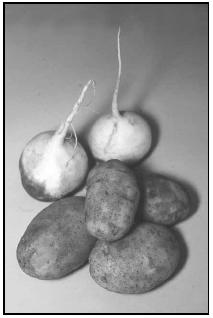
The British also celebrate Christmas, New Year's Day, Easter, and Guy Fawke's Day (November 5). A goose or turkey, mincemeat pies, wassail (spiced warm beverage), and plum pudding are served at Christmas, and crackers filled with candy and little toys are broken open by children.
Individual Mincemeat Pies
Ingredients
- 1 cup flour
- Pinch of salt
- ½ cup butter (1 stick)
- 1 egg yolk (separate the egg and discard the white)
- 2 Tablespoons water
- 1 can mincemeat
- Several Tablespoons of milk
- Several Tablespoons of powdered sugar
Procedure
- Preheat oven to 400°F.
- Make pastry (may use commercial piecrust instead, and skip steps 2 through 6).
- Measure flour and salt into a bowl.
- Add butter, and rub the flour and butter together with very clean fingertips or a large fork until crumbly.
- Mix egg yolk with water and add to flour mixture, and combine well.
- Wrap the dough in wax paper and refrigerate for about 30 minutes, or for up to 24 hours.
- Dust the counter or cutting board lightly with flour, and roll out dough, using a floured rolling pin.
- Cut into rounds about 3 inches in diameter.
- Fit a round of dough into each cup of a 12-cup muffin pan.
- Gather up the dough scraps and cut out a second set of rounds for the top crusts. (These can be slightly smaller).
- Put 1 tablespoon of canned mincemeat into each cup.
- Dampen the edges of the pastry with a little water or milk, place the second round on the top, pinching the edges together to seal.
- Using the tip of a sharp knife, make a small hole in the pastry top of each pie.
- Using a pastry brush, brush the pastry with milk and dust with a little powdered sugar.
- Bake for about 25 minutes, until light golden brown. Cool before serving.
Serves 12.
5 MEALTIME CUSTOMS
The British traditionally eat four meals a day, including breakfast, lunch, tea, and dinner. The traditional English breakfast is fairly large, with eggs, sausage, mushrooms, tomatoes, and fried bread. However, many English people, with schedules too busy to allow for a cooked breakfast, eat a wheat cereal similar to shredded wheat called Wheatabix with milk. Orange marmalade on toast is also popular. Tea with milk and sugar is the preferred beverage.
The Scots eat oatmeal for breakfast. Lunch and dinner can be interchanged, consisting of meat-and-potato dishes and small salads. Tea is taken around 4 P.M. with sandwiches, cakes, chocolate, or fruit. The biggest meal of the week, Sunday lunch, is served in the afternoon, and features roast beef, lamb, or pork; vegetables, often in a casserole or with sauce, such as Cauliflower Cheese; potatoes, and other side dishes. In casual conversation, the British use the term "pudding" in a general way to refer to dessert, even if the dessert being served is not actually pudding.
Wassail
Ingredients
- 1 gallon apple cider
- 1 large can pineapple juice (unsweetened)
- ¾ cup strong tea
- 1 Tablespoon whole cloves
- 1 Tablespoon whole allspice
- 2 sticks cinnamon
- Cheesecloth
Procedure
- Make a mug of tea, using 2 teabags.
- Place the spices in a square of cheesecloth, and tie securely with clean kitchen string. (If cheesecloth is not available, spices may be added directly to the mixture and strained out before serving.)
- Pour juices and tea into a large kettle, and place over low heat. Add cheesecloth bag filled with spices.
- Simmer for at least one hour (up to 6 hours).
Serves up to 20 people.
Sunday Lunch Cauliflower Cheese
Ingredients
- 1 large head cauliflower
- 3 Tablespoons butter
- 3 Tablespoons flour
- 1 teaspoon prepared mustard (Dijon-style preferred)
- 2 cups milk
- 1½ to 2 cups grated cheddar cheese
Procedure
- Cook cauliflower: Cut cauliflower into bite-sized flowerets, and place in a saucepan.
- Add 2 cups of water (or less) to cover the bottom of the pan to about 1 inch. Cover the pot, and heat until the water boils.
- Cook for about 10 minutes, until the cauliflower is tender but not soft.
- Remove from heat, remove cauliflower from pot, and place it in a serving dish.
- Cover with foil and keep warm.
- Make sauce: Melt butter in a saucepan.
- Stir in flour gradually, stirring constantly with a wooden spoon or wire whisk.
- Lower heat and cook for about 5 minutes until the mixture thickens slightly.
- Stir in milk slowly, stirring constantly. Heat until the mixture just begins to boil.
- Lower heat, add mustard, and continue stirring and simmering the mixture for about 8 minutes.
- Remove the pot from the heat, and stir in the grated cheese gradually.
- Pour hot sauce over warm cauliflower, and serve immediately.
Serves 6 to 10.
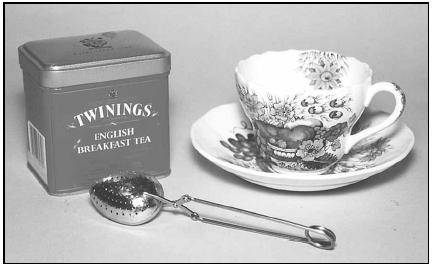
Tea with Milk
Ingredients
- Teabags of English tea, such as English Breakfast Tea or Earl Grey Tea
- ½ pint whole milk
- Sugar cubes
- Water
Procedure
- Fill a teakettle with water. Heat the water to boiling.
- Run hot water from the tap into the teapot to warm it.
- Place teabags, one for each cup desired, into the pot.
- (If the teabags have strings attached, wind the strings around the teapot handle to keep them from falling into the pot.) Carefully pour the boiling water over the teabags in the teapot.
- Allow to steep for three minutes.
- To serve, pour a small amount of milk into each teacup and pour in the tea..
- Add one or two sugar cubes (or more), if desired. Stir until sugar is completely dissolved.
- Sip tea and nibble on bikkies (biscuits, the English name for cookies).
6 POLITICS, ECONOMICS, AND NUTRITION
The UK depends on its farmers to grow good crops and raise healthy livestock. There is a law requiring all bulls be licensed by the government to help keep the cattle herds healthy and to guarantee that good breeding practices are observed. In the 1980s and 1990s, British livestock farmers struggled to combat diseases such as Mad Cow Disease (BSE—bovine spongiform encephalopathy) in cattle. After the first case was discovered in 1986, beef consumption in the UK dropped dramatically. Many countries also stopped buying beef raised in the UK, as a precaution against spread of the disease. At the beginning of the twenty-first century, an outbreak of "hoof and mouth disease" posed another serious threat against the livestock of the UK. Government agencies in the UK and elsewhere sought ways to combat and control these diseases, both of which could have devastating effects on the UK economy.
The children in the UK receive adequate nutrition generally, and there are few incidents of severe malnutrition in the country.
7 FURTHER STUDY
Books
Classic British: Authentic and Delicious Regional Dishes. New York: Smithmark, 1996.
Curran, William. The Best of Robert Burns . Edinburgh: The Book Guild, Ltd., 1999.
Denny, Roz. A Taste of Britain. New York: Thomson Learning, 1994.
Macdonald of Macdonald, Lady. Lady Macdonald's Scotland: The Best of Scottish Food and Drink . Boston: Little, Brown, 1990.
Passmore, Marian. Fit For Kings: A Book of Recipes. Bruton, England: King's School, 1994.
Paterson, Jennifer and Clarissa Dickson Wright. Cooking with the Two Fat Ladies. New York: Clarkson Potter, 1998.
Web Sites
BBC Online—Food. [Online] Available http://www.bbc.co.uk/food/recipes/ (accessed August 7, 2001).
Epicurious Food. [Online] Available http://food.epicurious.com (accessed January 15, 2001).
A Taste of Scotland. [Online] Available http://www.taste-of-scotland.com/ (accessed August 7, 2001).
A Taste of UK. [Online] Available http://web.ukonline.co.uk/tuk/index.html (accessed August 7, 2001).